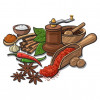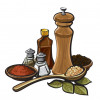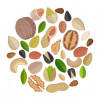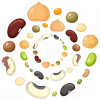Blog
Mouth Fresheners: A Whiff of Refreshment

Mouth fresheners, often a small but delightful part of our post-meal rituals, provide a refreshing conclusion to a satisfying meal. They come in various forms, from traditional to modern, and are not only meant to combat bad breath but also to offer a burst of flavor and rejuvenation. In this blog, we will explore the world of mouth fresheners, understanding their history, ingredients, cultural significance, and their role in our daily lives.
*A Brief History of Mouth Fresheners*
The tradition of using mouth fresheners dates back thousands of years. Various cultures have employed natural ingredients to freshen breath and cleanse the palate. The ancient Egyptians used spices and herbs, while the Greeks and Romans used mints and parsley for the same purpose. In Indian culture, the use of mouth fresheners has a long-standing tradition, with ingredients like fennel seeds and cardamom often being employed for their aromatic and digestive properties.
*Ingredients and Varieties*
Mouth fresheners come in a wide variety of forms and are created using diverse ingredients. Some of the common components of mouth fresheners include:
1. *Seeds and Spices*: Fennel seeds, anise seeds, cardamom, and coriander seeds are popular choices due to their aromatic qualities and digestive benefits.
2. *Mints*: Peppermint and spearmint are commonly used for their refreshing flavor and ability to mask odors.
3. *Herbs*: Cilantro, parsley, and basil are used in some cultures to freshen breath naturally.
4. *Candies and Chewing Gums*: Sugar-free candies and chewing gums often contain mint or fruity flavors for a quick burst of freshness.
5. *Betel Leaves and Areca Nuts*: In many parts of Asia, betel leaves and areca nuts are used as traditional mouth fresheners, though their use has raised health concerns due to their stimulant properties.
6. *Mouth Sprays and Strips*: Modern mouth fresheners may also include breath sprays and dissolvable breath strips for convenience.
*Cultural Significance*
The use of mouth fresheners holds cultural significance in many parts of the world. In India, for instance, offering guests a handful of mouth fresheners after a meal is a sign of hospitality and the conclusion of a satisfying dining experience. In Middle Eastern cultures, the chewing of gum mastic is a time-honored tradition. The act of sharing mouth fresheners often symbolizes camaraderie and hospitality, and in some cultures, it may even have ceremonial or religious connotations.
*The Dual Role: Refreshing and Digestive*
Mouth fresheners not only freshen your breath but can also have digestive benefits. For instance, ingredients like fennel seeds and cardamom are known to aid in digestion and alleviate post-meal discomfort. This dual role of providing refreshment and aiding digestion has made mouth fresheners a popular choice for people of various cultures.
*Modern Innovations*
While traditional mouth fresheners continue to be widely enjoyed, modern innovations have introduced a wide range of choices, including sugar-free mints and gums with novel flavors. These contemporary options cater to evolving tastes and preferences, offering convenient and portable solutions to maintain fresh breath on the go.
In conclusion, mouth fresheners are a small but delightful part of our culinary and cultural traditions. They offer a refreshing and flavorful end to a meal, help combat bad breath, and in some cases, provide digestive benefits. Whether you prefer the traditional simplicity of fennel seeds or the convenience of a modern breath strip, these little palate cleansers are a testament to the enduring importance of oral hygiene and the pleasure of a fresh and fragrant mouth.


 Spices
Spices Oil & Ghee
Oil & Ghee Namkeens & Snaks
Namkeens & Snaks Seasonings & Condiments
Seasonings & Condiments Mouth Freshener
Mouth Freshener Gifting Food Items
Gifting Food Items Poojan/Hawan Samagries
Poojan/Hawan Samagries Super foods
Super foods Food & Beverages
Food & Beverages Gourmet & World Food
Gourmet & World Food Nuts & Dry Fruits
Nuts & Dry Fruits Organic Foods
Organic Foods Premix & Ingredients
Premix & Ingredients Sweets
Sweets Tea & Coffee
Tea & Coffee
 Spices
Spices Oil & Ghee
Oil & Ghee Namkeens & Snaks
Namkeens & Snaks Seasonings & Condiments
Seasonings & Condiments Mouth Freshener
Mouth Freshener Gifting Food Items
Gifting Food Items Poojan/Hawan Samagries
Poojan/Hawan Samagries Super foods
Super foods Food & Beverages
Food & Beverages Gourmet & World Food
Gourmet & World Food Nuts & Dry Fruits
Nuts & Dry Fruits Organic Foods
Organic Foods Premix & Ingredients
Premix & Ingredients Sweets
Sweets Tea & Coffee
Tea & Coffee